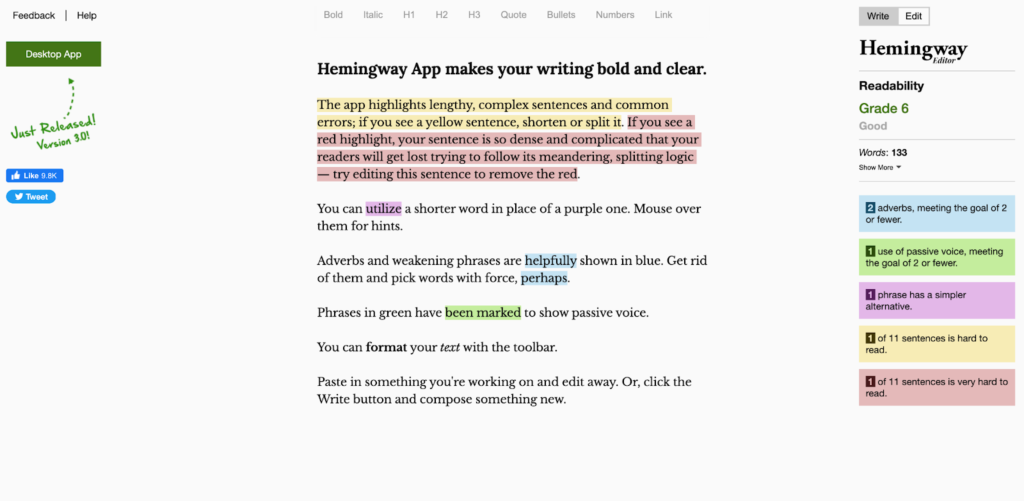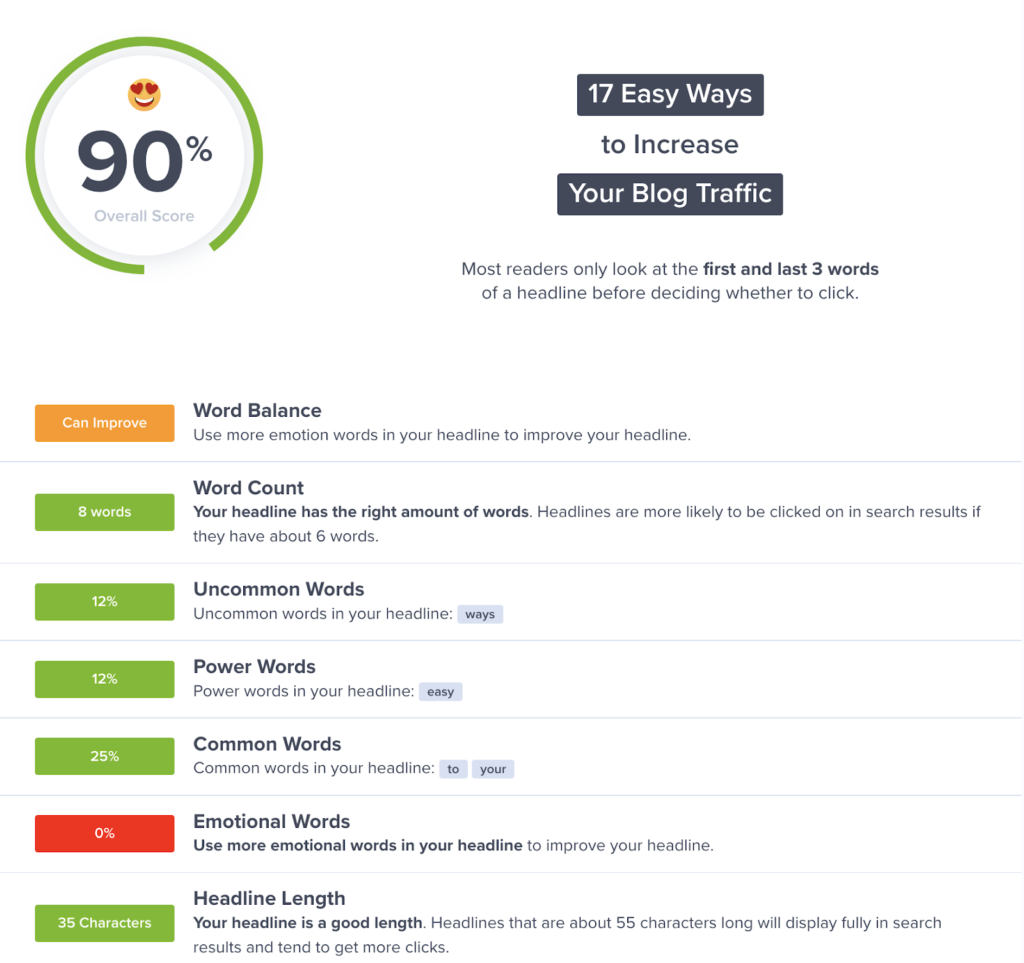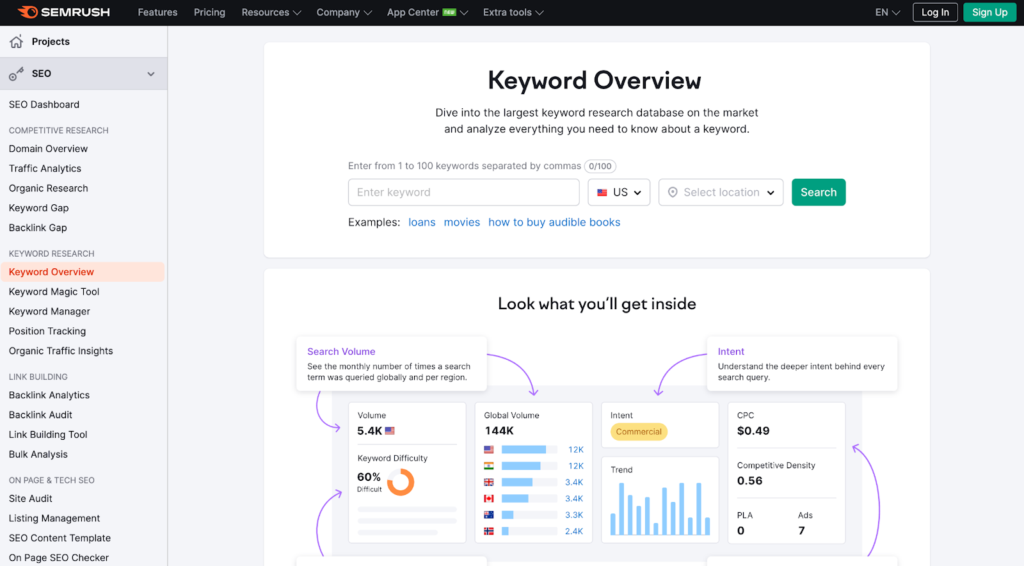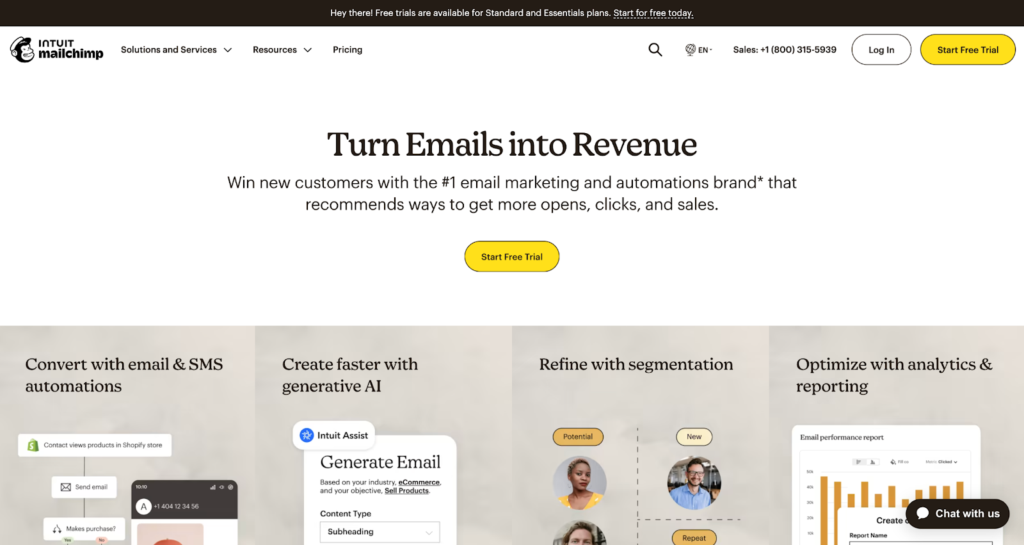Every blogger wants to be an industry pillar, but it’s hard to stand out amid the online noise. There’s a million and one writers out there, and you’re just one person. Feeling intimidated is completely normal.
While trying to boost your blog’s traffic can feel like trying to pull a rabbit from a hat, it’s actually somewhat of a science. We’ve spent years studying the strategies for growing blog readership, and we’re happy to share the secret to success.
In this article, we’ll show you how to increase blog traffic. These tips are great for beginners but also perfect for professional bloggers who want to take their monthly views up a notch.
Let’s dive in.
-
17 easy ways to increase your blog traffic in 2024
17 easy ways to increase your blog traffic in 2024
Focus in on your niche
The first key strategy on how to increase blog traffic is to focus intently on your niche. You can absolutely write about trends in technology and your grandmother’s baking recipes, just not on the same blog.
The underlying rationale for focusing on your niche lies with your audience. Visitors want to know what they can expect when they visit your blog, and if you don’t deliver on those expectations, they’ll bounce—literally.
Your website’s bounce rate is the percentage of people who visit your website, look at one page, and leave. Google tracks this and tracks how long someone stayed on your site (average visit duration). These metrics tell Google when your blog post is or isn’t what visitors are searching for.
By focusing in on your niche, you can create curated content your audience wants to see, decreasing your bounce rate and increasing the average session duration.
Diamond Lee, a digital content creator, recommends having a solution-oriented mindset. “If you focus on finding that one thing within a profitable niche that people are trying to find a solution to, you’ll never have to scratch and claw for sales in your business—nor will you have to convince people that they need your product,” she explains. “Then, when you craft the message, it will feel like you’ve read your target customer’s mind.”
Related: How To Find Your Niche in 4 Simple Steps (Expert Tips)
Write more long-form blog posts
Adding a little bit of extra length to your articles can significantly increase blog traffic. Once you know what you’re writing about, do a quick search of your title, and read the first two or three articles that come up.
Copy and paste the text from each article into a word counter, and then aim to write 15-20% more than them. Long-from articles are more likely to be shared, earn backlinks (more on those later), and consequently rank higher in Google.
However, write with caution. Many writers hear “write longer posts” and find ways to stretch their content further. If you lengthen your posts by adding fluff or repetitive content, readers will see your articles as less valuable overall.
So, instead, look for new subtopics to include in your post, add relevant examples, or even include helpful charts and tables. The goal isn’t just to add to your word count, it’s to add more value to your article. Value is what attracts and keeps readers interested.
Related: How to Write a Blog Post (10 Foolproof Tips)
Use simpler language
There are tons of tools and tricks that can help you drive more traffic to your site. Here’s how to increase blog traffic for free.
Use language that’s easy to understand.
Remember your bounce rate and session duration? Your language can affect these, too. If readers visit your site only to be met with super fancy or technical language, they’ll leave in search of something easier to understand.
Unless you run a blog on a highly specialized and high-skill topic, you’ll rarely need to use fancy or technical words. Many writers fall into this trap because they believe using fancy or technical language makes them appear more credible—spoiler alert, it doesn’t.
So, here are two general rules to remember when writing your next blog post:
- Try writing using active voice rather than passive. For example, “The blogger wrote a complex article” is easier to understand than “The complex blog post was written.”
- Avoid using technical or trade-specific language when possible. If you can’t avoid those words, like when we mentioned bounce rates, provide a definition. Another example of complex word usage is “utilize” vs. “use” or “due to the fact” and “because.”
Sure, English isn’t everyone’s favorite school subject. We get it. So, try adding Grammarly and the Hemmingway Editor to your tech lineup. These free tools analyze your word choice, clarity, and complexity and help you simplify your language. Give them a try!

Including images and videos
Still wondering how you can increase your blog traffic without breaking the bank? Try adding free stock images to your posts. Images can help to add visual interest to what would otherwise be walls of black and white text.
Pexels is a free library of over 3 million photos and videos. And if you create video content, consider using Coverr or Pixabay for free stock footage. While adding videos to your blog posts can also add visual interest, they’re also great at increasing your average session duration.
If a visitor views a video on your website without leaving the page, all of their viewing time is counted as on-page time. That’s great news for your session duration!
But again, the goal is to add value. Adding photos and videos isn’t a “hack” if it doesn’t add value. The goal is to support your visitors better, so they want to stick around longer and visit other pages on your site.
Choose better titles
Your article title is the first thing people will see about your article. Those impressions count and can make a real difference in whether people open your blog or skim past it on Google.
Ideally, your article title should be short and punchy—the opposite of a PubMed title. It should have some intrigue and contain your primary keyword near the beginning.
However, go too SEO-heavy and you’ll look like you’re just writing for the robots, but neglect keywords, and Google’s robots may not find and rank your article. The trick is to strike the right balance between appealing to your human reader while following SEO best practices.
Want another free tool to help you with titles? Check out OptinMonster’s free headline analyzer tool. This tool will give you an easy-to-read breakdown and rating of your headline, assigning color-coded percentages to things like word choice and length. Here’s what happened when we plugged in the headline for this article.

Incorporate keywords
Keywords are the words and phrases people type into Google when searching for information about a specific topic. To increase blog traffic, include these keywords in your article title, opening paragraph, H2 and H3 subheadings, and throughout your content.
Search engines will then begin to show your post in their search results. As people click on the article, bounce, click around, and more, search engines will move your article up or down in ranking.
Again, the tricky part about SEO is writing for computers AND humans simultaneously. A keyword like “best organic hypoallergenic dog food brands USA” would be hard to write into a blog post naturally. In most cases, you’ll also have secondary and tertiary keywords to target. For example, “best hypoallergenic dog food” or “organic dog food brands.”
Ahref’s free keyword generator or Semrush’s keyword research tools are both amazing resources for keyword research.

Break up the walls of text
Having your whole article formatted as a massive block of text makes it intimidating for readers—and it can actually hurt your search rankings and traffic. Instead, break up your article with subheadings, lists, and bullet points so your article is easily skimmable.
This works on two levels. First, it makes it easier for viewers to jump to the sections that are important to them. They’ll stay on the page longer, which decreases your bounce raten and increases your chances of ranking highly.
Google also uses section headers and headlines to scan for keywords. Adding more structure to your article can help you place keywords in the spots where they’ll make the biggest SEO contribution.
Adding internal links
Internal links are links to other blog articles you’ve published on your website.
Adding internal links to your blog posts has three key benefits:
- Internal links help search engines discover your content faster. Google is constantly rereading articles its ranking for any changes. If you link to a new article in an article that’s already published and ranking, Google will discover it faster, which helps you to rank faster, too.
- Internal links boosts blog post rankings. Visualize this: each internal link represents a thread from one blog post to another. As you add more and more links, there are more and more threads, creating a web-like structure. Now, when one article ranks highly on Google, the articles it links to also receive an SEO boost by association. That can mean a boost in performance for every connected article.
- Internal links increase engagement. Your most engaged and loyal readers will naturally be interested in what else you have to say, whether that’s about the topic at hand or similar topics. Internal links signal to readers that you’ve either found or curated additional content that’s related to what you’re talking about.
You have complete control over your internal links, so use them wherever relevant. And if you want more information on internal links, check out our article on link-building, where we cover this in-depth. (See what we did there?)Get more backlinks
Backlinks are the opposite of internal links. Backlinking refers to links to your website from other websites. The more backlinks your blog has, the more credible it looks to Google, and the more highly you’ll get ranked in the search results. (That means way, way more traffic!)
Now, you can spend several hours each day or just a few minutes focusing on your backlinking strategy. Setting goals, developing a strategy, and sticking to it can help you manage your time wisely.
Here are a few things you can do to generate more backlinks:
- Guest post – Write high-quality posts with a link to your website for other websites in your niche or in relevant niches.
- Create resource pages – These are high-value pages that others will naturally link to. These include posts like statistics posts, how-to guides, and other resources.
- Identify broken links – Identify broken links on other sites that your site could replace. Reach out to the site owner and suggest an update. This will help their site and yours.
- Get listed in directories – Reach out to sites that compile listings and directories of niche-specific businesses and resources.
It’s also wise to invest in general awareness techniques. Publishing on public forums, sharing to social media, and networking are all activities that will get your business in front of potential visitors, even if these things don’t result in a backlink.
It’s worth mentioning: you should never try to game the system. While getting a backlink from a credible source (like the NYTimes or a top industry blog) can really boost your search ranking, using link farms will get you penalized. Nobody can outsmart Google, so it’s not worth trying.
Create pillar pages
A pillar page is a blog post or web page with comprehensive coverage of a topic relevant to your industry. In the past, people would throw “everything but the kitchen sink” at a pillar page. The goal was to create a super in-depth post about everything you could want to know about the primary topic.
Today, creators look at pillar pages like the hub of a wheel. It acts as the center structure, and both supports and is supported by the spokes attached to it.
In the broader context of your content strategy, you can write pillar pages before you have other blog posts to link to or after all your related blog posts have been written. However, the goal is to link all related blog posts to this pillar page.
Why? Linking back to pillar pages provides a better user experience for viewers reading your articles, and it makes it easier for them to find all the information they need. It’s a no-brainer.
Here’s an example. Say you have a blog about raising puppies. One of your content clusters could focus on the golden retriever. So, your pillar page might be something like “The Comprehensive Guide to Raising a Golden Retriever Puppy.” This page could then introduce the breed, list the basic needs of a golden retriever puppy, explain any training or socialization needs, and present common challenges. This pillar page would be hyperlinked to more specific, in-depth articles on each topic.
So, not only does this pillar page act as a valuable resource page (great for backlinks), but it also relies on a comprehensive internal linking strategy. So when one of your posts ranks well, they all perform slightly better. And don’t forget your audience! Your audience will naturally benefit from your long list of valuable resources and posts.
Leverage social media
Sure, you can hit “Publish” on that blog post and exit the browser. Google will work its magic with or without further input from you. But why not do what you can to help your hard work perform even better?
As a tactic on how to increase blog traffic for each article, plaster your posts all over your social media accounts. Share them, promote them, and make sure you’ve got every bit of value out of them before moving on.
Two of the most effective places for how to increase blog traffic for free are sharing blog articles on Instagram stories and X. For X, you’ll want to include a short caption, a tag for anyone featured in your article, and a link to the article. On Instagram stories, you’ll want to include a screenshot of your article, a swipe-up link, and a little caption, adding context for your followers.
Repurpose blog content for social media
Sharing your blog articles on social media is just the start, though. To make the most of your most limited resource—time—you should also be repurposing your articles for social media content. Doing this’ll build your brand on multiple platforms and redirect new viewers to your blog.
When you repurpose blog posts, you’re turning them into new forms of content so they blend into each social platform and appeal to the audiences there. Repurposing content is like turning last night’s roasted chicken and vegetables into a vibrant salad with fresh greens, feta cheese, and homemade vinaigrette.
Publish guest contributors—or interview them!
Know someone in your industry whose voice you’d like to spotlight? Ask them if they’d be interested in sitting down for an interview or writing a guest post for your blog.
This kind of exchange benefits you both. The guest can flex their knowledge, reach a brand-new audience, and have your blog’s credibility rub off on them. And for you, it means excellent content and a guaranteed bump in awareness, as guests always share their posts with their audience.
Use paid advertising
After sharing and repurposing blog content on social channels, paid advertising can increase blog traffic even more. In most cases, you’ll just hit “boost post” on whichever social platform you use and watch the clicks shoot up.
Promote a post that links to your blog so you drive new traffic directly from your ads. And you don’t need to advertise everywhere—just focus on the networks where you’ve already got the most traction, whether that’s X, Facebook, Instagram, or something else!
Paid advertising doesn’t have to be a costly endeavor. The major social networks let you choose your advertising budget, so you can spend as much or as little as you want. You can also run campaigns based on the demographics you want to target, so you’re connecting with the right people and stretching your budget as far as it can go.
The potential payoff for using social ads is even higher if you can direct visitors toward bottom of the funnel content. This is content like blog posts, ebooks, or how-to guides that lead visitors to other paid content or your email lists.
Related content: How to Sell Online Courses on Social Media
Start a mailing list
Building an email list is a tried and true way to increase blog traffic and engage with your audience. But in addition to driving more traffic to your blog, email lists also help you:
- Communicate directly with your audience
- Send targeted messages
- Drive consistent traffic to your site
- Retain readers over longer periods of time
- Gather feedback and valuable insights from your audience
- Monetize your content
- Adapt to changes in your niche, industry, and market
- Automate engagement and marketing
George Pitts created a seven-figure business by selling digital products. Here’s what he has to say about email marketing:
“With email, everyone who has put in a valid email address is going to receive it. With Instagram, you’re only guaranteed to get views from a small percentage of who Instagram decides to show your information to.”
If you’re wondering how to increase blog traffic for free, starting your own email list is a good step. You’ll first need to select an email marketing platform like Mailchimp. Add a form to your website and encourage readers to sign up for an email newsletter.

Once you’ve built up a list of subscribers who aren’t your mom and childhood besties, start sending out bi-weekly or monthly round-ups. These emails remind people to check out your blog, which will add to your website’s traffic.
The newsletter format is extremely flexible. You can summarize your latest blog posts, shout out industry trends, or even include links to upcoming courses you’re selling.
Optimize your website’s loading speed
Beyond content creation and promotion, there are technical tweaks you can make that will help boost your blog traffic. The first and most crucial is optimizing your website’s loading speed so that viewers can get straight to reading.
If your page takes five seconds to load, the probability of visitors bouncing rises by 90%, which isn’t good. As mentioned earlier, Google tracks page loading speeds and bounce rates. So, a slow website will hurt your search rankings.
Try measuring your page speed with Google’s free tool, PageSpeed Insights. Consider upgrading your domain hosting or blogging platform if you’re seeing serious lag.
Keep your blog’s design clutter-free
Finally, you’ll want to keep your blog’s design simple and navigable. Web design plays an important role in SEO because it significantly impacts the user experience.
If you have bad website design, readers will read at most one article. They’ll get lost, distracted, or disoriented by all the clutter. And if they leave quickly, they’ll negatively impact your bounce rate and session duration.
But, if your blog is sleek, well-designed, and easy to navigate, skimming an initial article can turn into binge-reading sessions and repeat visits.
Looking for even more tips on how to increase website traffic? This blog shares dozens of ways!
Other related educational articles on blogging:
- How to Start a Blog (And Make Money on It)
- What Is a Blog? And Why Should You Create One?
- What Blog Topics Should I Write About? (Ideas & Steps)
- How to Make Money Blogging: 8 Proven Ways to Monetize Your Blog
What’s next?
Now that you know how to increase your blog traffic, you might be looking for ways to turn the content you blog about into profitable online courses. (Especially if you’re an entrepreneur or educator.)
That’s where Thinkific comes in. We make it easy to scale your business by offering self-guided online courses and membership sites. Our easy-to-use course design platform helps coaches, educators, and digital content creators build engaging, custom eLearning experiences and grow sustainable online businesses.
Try Thinkific for free and get the course creation, marketing, and selling tools you need to take your business up a notch. (No tech skills required!)
This blog was originally published in June 2022, it’s since been updated in October 2023.





